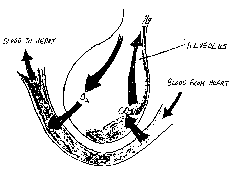Education Links
Leaving Cert
 Maths
Maths
 French
French
 English
English
 Chemistry
Chemistry
 Physics
Physics
 Biology
Biology
 Economics
Economics
 Spanish
Spanish
 Geography
Geography
 History
History
Junior Cert
Definitions
BreathingThe physical process of taking air into and out of the lungs.
Respiration
The chemical process of releasing energy from food.
Parts of the Breathing System
Click here for a diagram of the breathing system.Mouth and nasal passages
Air is
(a) Moistened
(b) Warmed
(c) Filtered by the mucus and the hairs in the nose.
Pharynx
Region at the back of the nose and throat. The epiglottis is a flap of tissue, which closes off the windpipe when swallowing. Just below the epiglottis is the larynx (voice box). It contains two folds of membranes movement of air across these membranes produce sound.
Trachea
The trachea (windpipe) connects the pharynx to the lungs. At the lower end the trachea divides into two smaller tubes the bronchi leading to the lungs. Each bronchus on entering the lung divides repeatedly to give rise to a number of tubes called bronchioles. The bronchioles end in tiny air sacs called alveoli. The trachea and the bronchi are prevented from collapsing by c shaped rings of cartilage.
Lungs
Soft spongy organs where exchange of gases takes place.
Comparing breathed in and breathed out air
The air breathed out differs in the following ways:- Warmer
- More moist
- More carbon dioxide
- Less oxygen
- Less dust
- Different odour
- Different proportion of nitrogen
Mechanism of breathing
Inspiration- The diaphragm and intercostal muscles contract
- The diaphragm flattens
- The rib cage moves up and out
- The volume of the thoracic cavity increases therefore the pressure decreases
- The pressure of the air outside the body is now greater than the pressure of the air in the chest
- Gas flows from higher pressure to lower pressure
- As a result air flows into the lungs
- It is an active process (energy is required) because muscles are contracting
- The diaphragm and intercostal muscles relax
- The diaphragm moves up to its relaxed dome position
- The rib cage moves down and in
- The volume of the thoracic cavity decreases therefore the pressure increases
- The pressure of the air in the chest is now greater than the pressure of the air outside the body
- Gas flows from higher pressure to lower pressure
- As a result air flows out of the lungs
- It is a passive process (energy is not required) because muscles are not contracting. Expiration only requires energy during strenuous exercise.
The rate of breathing is controlled by the respiratory centre in the medulla oblongata at the base of the brain. When the level of CO2 in the blood increases the medulla sends impulses to the intercostal muscles and the diaphragm causing them to contract. Exercise increases the rate of respiration therefore it increases the amount of CO2 in the blood. As a result the rate of breathing is quickened and deepened.
 |
Experiment 1 To show the effect of exercise on the rate of breathing |
Lung capacity
Tidal volumeThe amount of air that passes in and out of the lungs during a single breath at rest. This is about 500cm3.
Inspiratory reserve volume
The amount of air over and above the tidal volume that can be inhaled during a deep breath. This can be up to about 2500cm3.
Expiratory reserve volume
The extra amount of air that can be expelled from the lungs after normal expiration, to empty them as much as possible. This can be up to about 1000cm3.
Vital capacity
This is the maximum amount of air that can be taken in ore forced out of the lungs in one breath.
Vital capacity = Tidal volume + Inspiratory reserve volume + Expiratory reserve volume = 500cm3 + 2500cm3 + 1000cm3 = 4000cm3
Residual volume
The amount of air that is left in the lungs after as much air as possible has been forced out. This is 1500cm3 approx.
Total capacity
Vital capacity + residual volume = 4000cm3 + 1500cm3 = 5500cm3
Gaseous exchange in the alveoli

- As a result of respiration the cells of the body use up oxygen and produce carbon dioxide.
- The carbon dioxide diffuses into the blood stream.
- In the lungs the Carbon dioxide diffuses from the blood stream into the alveoli.
- In the lungs the oxygen diffuses from the alveoli into the blood stream.
- The oxygen then diffuses from the blood stream into the cells of the body.
 |
Experiment 2 To show that exhaled air contains more carbon dioxide than inhaled air. |
 |
Experiment 3 To demonstrate how the diaphragm affects breathing using the 'artificial lung' experiment. |


